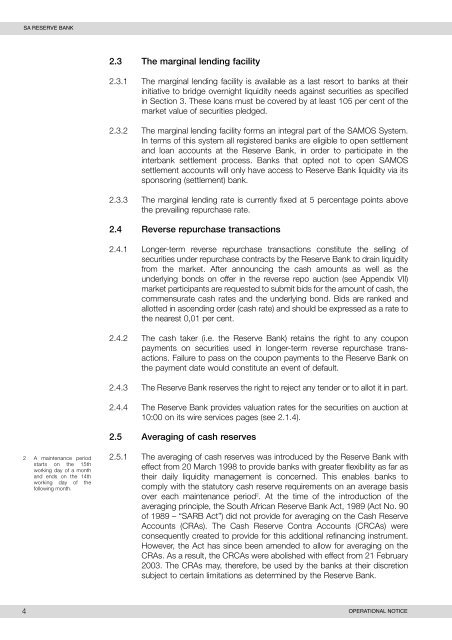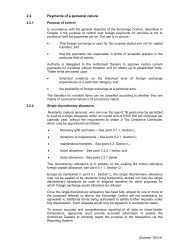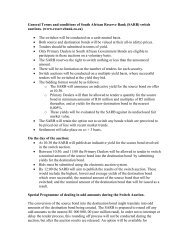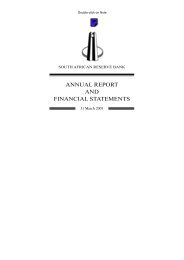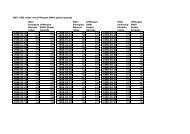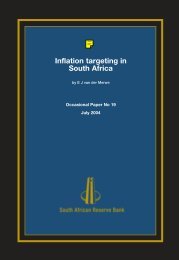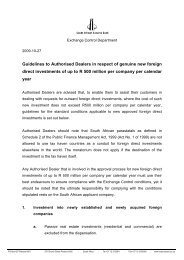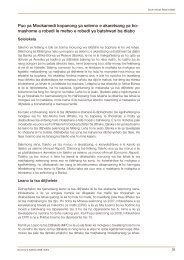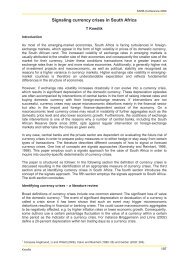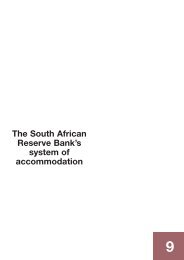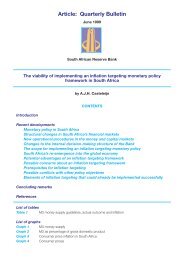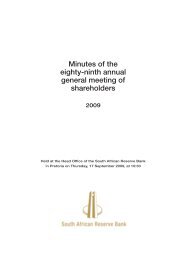Operational Notice - South African Reserve Bank
Operational Notice - South African Reserve Bank
Operational Notice - South African Reserve Bank
You also want an ePaper? Increase the reach of your titles
YUMPU automatically turns print PDFs into web optimized ePapers that Google loves.
SA RESERVE BANK2.3 The marginal lending facility2.3.1 The marginal lending facility is available as a last resort to banks at theirinitiative to bridge overnight liquidity needs against securities as specifiedin Section 3. These loans must be covered by at least 105 per cent of themarket value of securities pledged.2.3.2 The marginal lending facility forms an integral part of the SAMOS System.In terms of this system all registered banks are eligible to open settlementand loan accounts at the <strong>Reserve</strong> <strong>Bank</strong>, in order to participate in theinterbank settlement process. <strong>Bank</strong>s that opted not to open SAMOSsettlement accounts will only have access to <strong>Reserve</strong> <strong>Bank</strong> liquidity via itssponsoring (settlement) bank.2.3.3 The marginal lending rate is currently fixed at 5 percentage points abovethe prevailing repurchase rate.2.4 Reverse repurchase transactions2.4.1 Longer-term reverse repurchase transactions constitute the selling ofsecurities under repurchase contracts by the <strong>Reserve</strong> <strong>Bank</strong> to drain liquidityfrom the market. After announcing the cash amounts as well as theunderlying bonds on offer in the reverse repo auction (see Appendix VII)market participants are requested to submit bids for the amount of cash, thecommensurate cash rates and the underlying bond. Bids are ranked andallotted in ascending order (cash rate) and should be expressed as a rate tothe nearest 0,01 per cent.2.4.2 The cash taker (i.e. the <strong>Reserve</strong> <strong>Bank</strong>) retains the right to any couponpayments on securities used in longer-term reverse repurchase transactions.Failure to pass on the coupon payments to the <strong>Reserve</strong> <strong>Bank</strong> onthe payment date would constitute an event of default.2.4.3 The <strong>Reserve</strong> <strong>Bank</strong> reserves the right to reject any tender or to allot it in part.2.4.4 The <strong>Reserve</strong> <strong>Bank</strong> provides valuation rates for the securities on auction at10:00 on its wire services pages (see 2.1.4).2.5 Averaging of cash reserves2 A maintenance periodstarts on the 15thworking day of a monthand ends on the 14thworking day of thefollowing month.2.5.1 The averaging of cash reserves was introduced by the <strong>Reserve</strong> <strong>Bank</strong> witheffect from 20 March 1998 to provide banks with greater flexibility as far astheir daily liquidity management is concerned. This enables banks tocomply with the statutory cash reserve requirements on an average basisover each maintenance period 2 . At the time of the introduction of theaveraging principle, the <strong>South</strong> <strong>African</strong> <strong>Reserve</strong> <strong>Bank</strong> Act, 1989 (Act No. 90of 1989 – “SARB Act”) did not provide for averaging on the Cash <strong>Reserve</strong>Accounts (CRAs). The Cash <strong>Reserve</strong> Contra Accounts (CRCAs) wereconsequently created to provide for this additional refinancing instrument.However, the Act has since been amended to allow for averaging on theCRAs. As a result, the CRCAs were abolished with effect from 21 February2003. The CRAs may, therefore, be used by the banks at their discretionsubject to certain limitations as determined by the <strong>Reserve</strong> <strong>Bank</strong>.4 OPERATIONAL NOTICE


